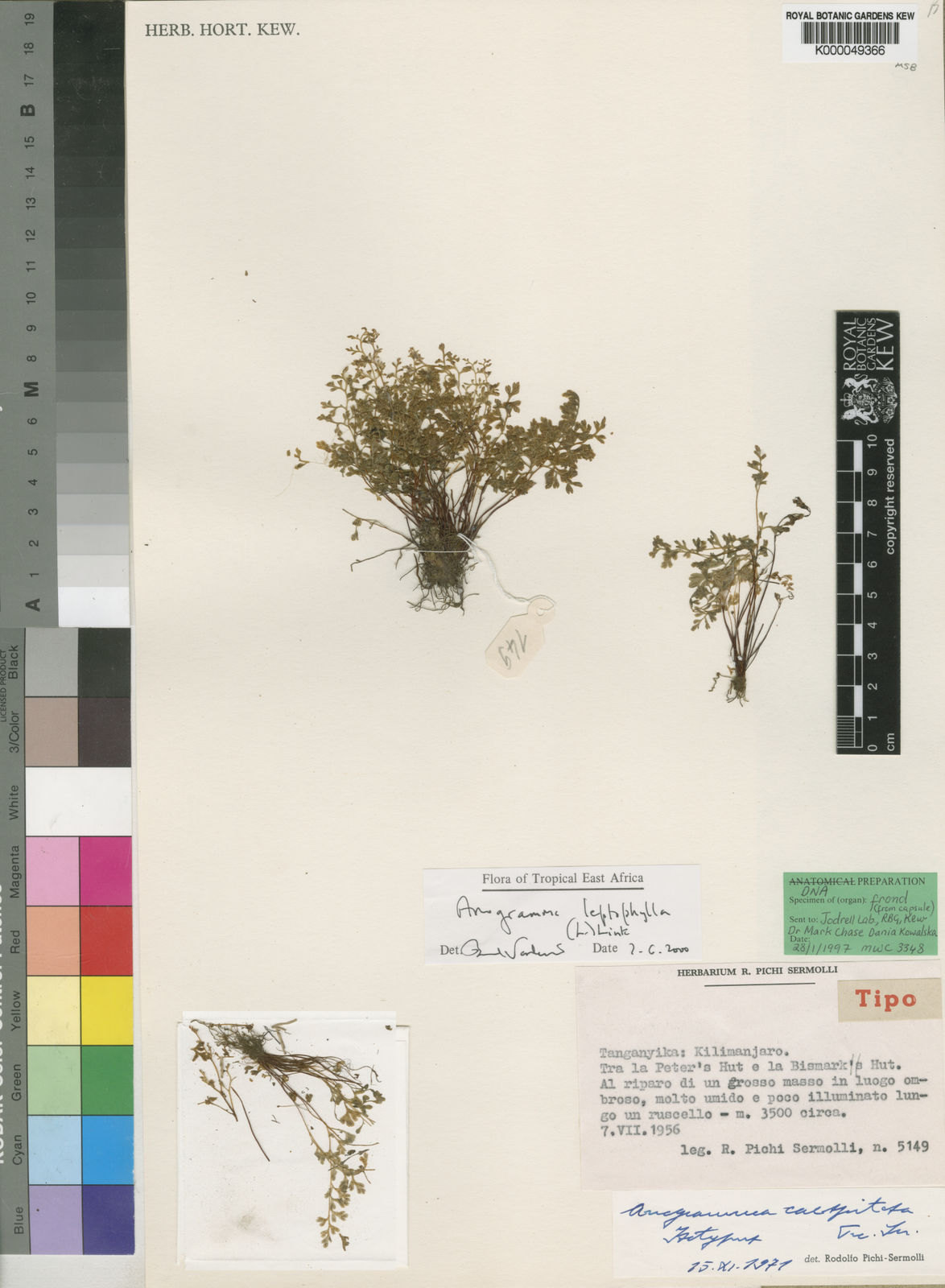Copper Fern
anogramma leptophylla
Also known as: ["Copper Fern","Slender Maidenhair Fern"]
Overview
A delicate, deciduous fern with copper-colored fronds, native to temperate regions.
Benefits & Perks
["shade tolerant","aesthetic foliage","wildlife attractant (bees, butterflies, birds)"]
Botanical Classification
| Phylum: | Tracheophyta |
| Class: | Polypodiopsida |
| Order: | Pteridales |
| Family: | Pteridaceae |
| Genus: | Anogramma |
| Botanical Name: | Anogramma leptophylla |
Plant Characteristics
Basic Information
- Category: Leaf Plants
- Suitable Location: shaded garden bed or container with protection from strong winds
- Suitable For:
- Is Weed: No
- Allergenicity: low
Environmental Needs
- Climate: {"temperatureRange":"5–25°C"}
- Hardiness: {"zones":"8–10"}
- Misting: every 2–3 days to maintain high humidity
- Drainage: Fast-draining to prevent waterlogging.
- Soil Type: Well-draining, slightly acidic soil with organic matter and sand or perlite.
Maintenance Level
- Maintenance Level: moderate
- Toughness Level: moderate
- Pruning Frequency: As needed, typically during spring or early summer.
- Pruning Intensity: Light pruning; focus on removing only dead or yellowing fronds.
Care Details
Ideal Sunlight Coverage:
Bright, indirect light for 4–6 hours daily; tolerates partial shade; adjust exposure based on intensity.
Sunlight Tolerance Tips:
Acclimate gradually to intense light; protect from direct midday sun; adjust placement seasonally to avoid scorching.
Care Requirements
Care Difficulty
moderatemoderate
Sunlight
partial shade to full shade
Avoid direct afternoon sun; rotate plant for even growth; provide dappled light if outdoors.
Watering
every 7–10 days during active growth, reduce in dormancy
Water deeply but infrequently; ensure excellent drainage; avoid waterlogged soil.
Soil
well-draining, humus-rich soil
pH: Slightly acidic to neutral (pH 5.5–7.0).
Avoid heavy clay soils; maintain consistent moisture without saturation; enrich with organic matter.
Temperature
Prefers cool to moderate temperatures (50–70°F or 10–21°C); thrives in cooler conditions; sensitive to heat.
Keep away from drafts; maintain stable temperatures; avoid sudden fluctuations.
Fertilizing
every 4–6 weeks during growing season, none in dormancy
Dilute fertilizer to prevent burn; fertilize only when actively growing; flush soil occasionally to prevent salt buildup.
Propagation
Methods
Spores or division of rhizomes.
Step-by-Step Propagation Guide
- Collect spores from mature fronds.
- Scatter on sterile medium.
- Keep moist and warm.
- Or divide rhizomes carefully and replant.
Best Time: Spring or early summer when the plant is actively growing.
Environment
High humidity (70–90%), warm temperatures (65–75°F or 18–24°C), and indirect light.
Medium
Mixture of peat moss and sand or specialized spore-starting medium.
Hormone
Not required for spores; division may benefit from rooting hormone.
Timeline
Spores may take 1–3 months to germinate; division establishes quickly within weeks.
Tools Needed
Spore collection tools, sterile medium, spray bottle, pots.
Quick Tips
Use a humidity dome for spores; divide only healthy rhizomes; keep medium consistently moist.
Pruning & Repotting
Pruning Guide
Method
Snip individual fronds at the base with clean cuts.
Pruning Plan
Minimal pruning; remove dead or damaged fronds to maintain appearance and health.
Tools
Clean, sharp scissors or pruning shears.
Checklist
Disinfect tools; remove only dead/damaged fronds; avoid over-pruning.
Repotting Guide
Best Season
Early spring before active growth begins.
Pot Size
One size up from current pot; ensure adequate drainage holes.
Method
Use fresh, well-draining soil; gently tease apart roots; ensure proper drainage.
Suggestions
Repot only when overcrowded or root-bound; typically every 2–3 years.
Checklist
Use fresh soil; check for root rot; ensure proper pot size.
Advanced Care Tips
Watering Mastery
Watering Checklist
Check soil moisture before watering; water at the base; ensure drainage; adjust for season.
How to Apply Water Properly
Water directly at the root zone until water drains from the bottom; ensure even moisture without saturating; water in the morning to allow foliage to dry.
Watering Schedule Tips
Water sparingly during active growth, allowing soil to dry slightly between waterings; reduce watering significantly in dormancy (winter); adjust based on humidity and temperature.
Soil Improvement
Add perlite or sand for drainage; incorporate peat moss for acidity; ensure aeration.
Temperature Stress Management
Signs of Temperature Issues
Wilting, yellowing fronds, stunted growth, or browning leaf edges.
Cold Stress
Slows growth, may cause fronds to turn brown or die back; can enter dormancy.
Solution: Provide protection from frost; maintain consistent cool temperatures; reduce watering during dormancy.
Hot Stress
Fronds may wilt, scorch, or dry out; growth may cease.
Solution: Increase humidity, provide shade, and water more frequently but avoid waterlogging.
Fertilizing Guide
Fertilizing Checklist
Use diluted fertilizer; apply during growing season; avoid winter feeding.
Fertilizing Method
Use a balanced liquid fertilizer diluted to half strength; apply monthly during active growth (spring/summer); avoid fertilizing in winter.
Common Problems & Solutions
Toxicity Warning
Cats
Slightly ToxicCats may experience mild gastrointestinal symptoms if they ingest Anogramma leptophylla. The spores and fronds are the toxic parts, but the plant is not considered highly toxic to felines.
⚠️ Symptoms:
🌿 Toxic Parts:
⚡ Toxic If:
if eaten
Dogs
Slightly ToxicIn dogs, ingestion of Anogramma leptophylla can lead to mild gastrointestinal upset. The spores and fronds are the toxic components, but the plant is not considered highly toxic to canines.
⚠️ Symptoms:
🌿 Toxic Parts:
⚡ Toxic If:
if eaten
Humans
Slightly ToxicAnogramma leptophylla contains compounds that can cause mild gastrointestinal distress upon ingestion. The spores and fronds are the primary toxic parts, though the effects are generally not severe unless consumed in large quantities.
⚠️ Symptoms:
🌿 Toxic Parts:
⚡ Toxic If:
if eaten
Frequently Asked Questions
Q: How often should I water Anogramma leptophylla?
A: Keep the soil consistently moist but not waterlogged, especially during active growth.
Q: Does this fern require direct sunlight?
A: No, it thrives in partial to full shade.
Q: Is Anogramma leptophylla suitable for indoor cultivation?
A: Yes, but it requires high humidity and indirect light to thrive indoors.
Quick Reference
| Family: | Pteridaceae |
| Care: | moderate |
| Light: | partial shade to full shade |
| Water: | every 7–10 days during activ |
Get Expert Care Tips
Download the Plantious app for personalized care reminders and plant identification!
Google Play App Store








